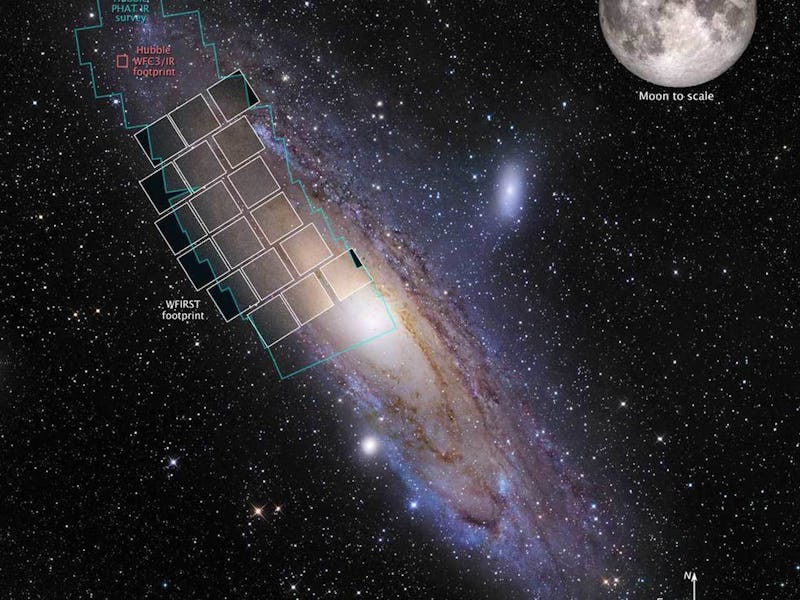NASA’s newest telescope to search for alien worlds and peer into dark energy
WFIRST, the telescope destined to replace the Hubble, just got the official green light.

The early years of the universe remain obscured to human eyes behind clouds of hot gas and subatomic particles. But a new telescope on the cosmic block may finally unravel some of the greatest mysteries of the young universe.
It could also help scientists answer for once and for all: Are we alone in the cosmos?
The Wide Field Infrared Survey Telescope (WFIRST) just got the official green light after NASA approved it for hardware development and testing, the space agency announced Monday.
The telescope’s massive outlook on the universe will allow it to detect faint infrared signals across large distances, as well as produce panoramas that stretch further across the cosmos than any telescope before it.
These abilities will be crucial if WFIRST is to succeed in unraveling the mystery of dark matter and dark energy — and discovering new exoplanets that may support life.
A worthy successor to Hubble?
WFIRST will answer questions about a trifecta of astrophysics mysteries — dark energy, exoplanets, and near-infrared surveys of the universe at large.
Ultimately, the telescope is designed to replace the Hubble, a bastion of space science that has led to some of the most incredible discoveries about our universe, including spotting the farthest star known to science, and that the universe is expanding far faster than we thought.
"WFIRST is designed to address science areas identified as top priorities by the astronomical community," Paul Hertz, director of NASA's Astrophysics Division in Washington, said in a statement.
“The Wide-Field Instrument will give the telescope the ability to capture a single image with the depth and quality of Hubble, but covering 100 times the area," of space, he said.
The new telescope will be equipped with a mirror just as large as Hubble's, but with a wider view of the cosmos.
The Hubble Space Telescope launched in April, 1990, but thanks to five servicing missions, the telescope is still going strong. But WFIRST is capable of imaging an area in the sky that is 100 times larger than that currently surveyed by Hubble, although both are fitted with a 2.4 meter mirror to peer at the universe through.
The new telescope is described as Hubble’s “wide-eyed cousin” by NASA, as a single image produced by WFIRST will have as much detail as 100 images produced by Hubble.
Mysteries of the dark side
By observing the universe with such great precision, astronomers hope to discover why the universe apears to be expanding at an accelerating rate.
At the heart of this mystery is dark energy, a form of energy that is thought to make up around 70 percent of the universe. Despite its abundance, dark energy has never been directly observed or measured.
WFIRST could change that. It is set to make the most precise measurements yet of how dark energy and dark matter influence the universe by observing cosmic phenomenon in action, including supernovae and the formation of galaxy clusters.
Scientists will then use these observations to measure the expansion rate of the universe.
WFIRST will carry a wide field instrument to survey large parts of the sky.
“To understand how the universe evolved from a hot, uniform gas into stars, planets, and people, we need to study the beginnings of that process by looking at the early days of the universe,” Jeffrey Kruk, WFIRST Project Scientist at NASA’s Goddard Space Flight Center in Maryland, said in a statement.
“We've learned much from other wide-area surveys, but WFIRST's will be the most sensitive and give us our farthest look back in time.”
Searching for exoplanets
Since the first exoplanet was discovered in 1992, scientists have searched the cosmos for more bizarre alien worlds and signs of life.
So far, we have discovered around 4,000 exoplanets orbiting around different stars, in large part thanks to NASA’s Kepler mission and the Transiting Exoplanet Survey Satellite (TESS).
WFIRST will follow in the cosmic footsteps of these missions, using a process called microlensing, whereby a star within the confines of our own galaxy serves as a lens to view more distant stars in the cosmos.
The telescope will monitor 100 million stars for hundreds of days, and is expected to find around 2,500 new exoplanets.
WFIRST is scheduled to launch in mid-2020’s, but while it has the initial green light, there is some uncertainty regarding its funding.
The telescope has a maximum projected cost of some $4 billion. Work on WFIRST is covered until September 2020 under the budget for the current fiscal year. But the proposed budget for the 2021 fiscal year suggests the termination of funding for WFIRST in order to focus on the James Webb Telescope, which is scheduled for launch in March 2021.
“The Administration is not ready to proceed with another multi-billion-dollar telescope until Webb has been successfully launched and deployed,” NASA said in a statement.
We'll keep our excitement on hold — for now.